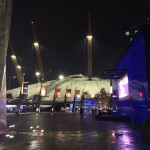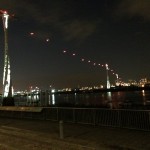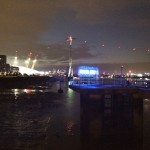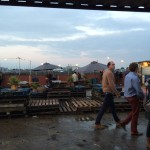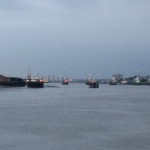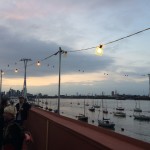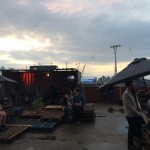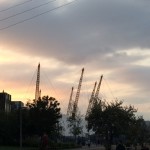There are doubtless many theatrical companies engaged in providing the public with “immersive theatre” productions like Shunt’s The Boy Who Climbed Out Of His Face. To the professional critics this is old hat, and them I say bully for you! The fact that I’ve never previously experienced anything quite like this one (and “experience” is absolutely the right word) probably tells you my relationship with theatrical events has largely been confined to the cosily conventional. Even the notoriously innovative Samuel Beckett never quite subjected his audience to this kind of ordeal, though he was scarcely the first to confront attitudes and platitudes.
What was apparent when I mentioned that daughter Lindsey and I had been to see TBWCOOHF was the number of friends who said something akin to “not my kind of thing.” Why? I wondered – are we really so conservative that we con’t want to be challenged by the theatre, to be distracted rather than engaged? Much as Frank Lloyd Wright said of television, theatre has become “chewing gum for the eyes.” Maybe this is why London theatres are full of shows like Mama Mia, We Will Rock You and Our House?
Lindsey and I chose this production because it was interesting, different, challenging, relatively short (45 mins) and relatively cheap (£10 + £2 booking fee.) The destination proved interesting too – East Greenwich Coaling Jetty, a venue known simply as The Jetty, as signified by a cool blue neon sign.
It took a little finding since we walked the wrong way out of North Greenwich station, where a wander past what is now known as the O2 arena (formerly the Millennium Dome) would have made it a cinch. However, once we arrived the views across the Thames, incorporating said O2, the cable car across London’s river, plus the office towers of Canary Wharf in one direction, the Thames Barrier in the other, were truly amazing, a backdrop fit for the greatest Shakespearean dramas.
However, this was not the Globe but a jetty with two sections: the open-air bar with a couple of containers for shelter and various reclaimed beams covered by umbrellas. Alongside the bar but closed on this occasion was another container offering food, both meaty and fishy. In the corner was a cloakroom in the form of a small shed and a narrow walkway towards the main arena.
But if you were expecting an auditorium with a proscenium arch, or even theatre in the round, think again. From the outside and above you can observe a collection of containers formed into a square. I shall return to what is in the middle, but the point is that what lies within is hidden from view. Photography is banned to heighten the sense of mystery, hence the pics of everything but the interior.
Before you actually enter the labyrinth (for that is what it amounts to), you are required to remove shoes and socks, which are then placed in white shoe boxes and carried around by their owner through the spectacle. The facts that you are barefoot and carrying around a box are both relevant to what happens within.
Oh, you want to know what happens? Right, well I’m not sure I could do it much justice in words, but suffice it to say that there are a series of rooms in which a wide variety of surreal experiences take place with individuals, all but one of whom are wearing torn latex masks.
At the end you go up the stairs and on to a balcony surrounding the courtyard in between the containers. There is a pool of water containing the submerged and distorted wreckage of a fallen container, split open. A long-haired man wearing several shift dresses plays and sings a mournful song on electric guitar and stares out into the night in the direction of the O2.
Each room contains its own absurdities and confrontational elements, each disorientating the audience with veiled dangers and sensory deprivation. You are part of the cabaret but without any clue what is really going on or what it means – but the fear is of the unknown and being challenged. Not least with the darkened sound room, the jungle and the lift, it reminded me strongly of being a member of the cast in Lost (anyone remember that series?)
The fact that there is very little dialogue, and a fair proportion of the mumbled words were in any case beneath my impaired hearing, did not really matter since your other senses are stimulated by this event. I can guess what the running themes and individual tableaux are getting at, but I suspect most viewers will imagine it much as they viewed the Twilight Zone in the late 50s – something beyond their comprehension but worth experiencing for the journey and the thought processes it provokes… though a fair proportion would instinctively hate it and want something conventional that would deliver laughs and tears and allow them to go home satisfied and fulfilled.
On balance my life is much the richer for having been through that experience, and on that basis I commend it to you – unless you only want light-hearted and unchallenging “entertainment” and variety performances. The world truly has moved on, such that we can now explore parts of the psyche and subconscious that up til now have lain dormant. Using all our senses and delving deeper into our minds seems to me an admirable function of theatrical resources.


